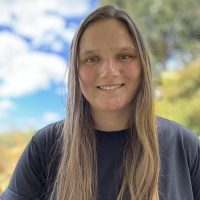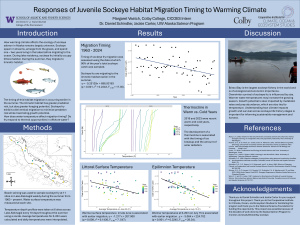
Margaret Veatch
Colby College
Research Mentor: Daniel Schindler, Jackie Carter
Project: Responses of Juvenile Sockeye Habitat Migration Timing to Warming Climate
Hello! My name is Margaret, and I’m a rising senior studying biology at Colby College. This summer, I had the incredible opportunity to work as a CICOES intern with Dr. Daniel Schindler and Jackie Carter, studying how climate change is affecting migration timing in juvenile sockeye salmon in Bristol Bay, Alaska. I was based at the Alaska Salmon Program’s field station on Lake Aleknagik, a nursery lake that supports numerous sockeye salmon.
Each summer, juvenile sockeye migrate from the littoral zone, near the lake’s shores, to the limnetic zone, farther offshore. To track this migration, we set beach seine nets at eleven sites around Lake Aleknagik each week. Early in the summer, we caught large numbers of juvenile sockeye, but as the season progressed and the fish moved offshore, we began seeing fewer in our seines. I also collected water temperature data from both the littoral and limnetic zones to investigate environmental cues driving this habitat shift.
The Alaska Salmon Program has collected data like this for over 60 years, which gave me the opportunity to look at long-term trends. I wanted to understand whether temperature in the littoral or limnetic zone better explained the timing of migration. I found a stronger relationship with limnetic temperatures: when offshore waters were warmer earlier in the summer, the sockeye migrated sooner. This may be due to both increased metabolic rates in the fish and earlier peaks in zooplankton abundance, their main food source, prompting the sockeye to move offshore to take advantage of better feeding conditions.
Bristol Bay is home to the world’s largest sockeye fishery and plays a crucial role in the regional economy and ecosystem. Understanding how climate change is shifting key life stages like juvenile migration can help inform sustainable management strategies into the future. Beyond my research, I contributed to other field projects and long-term monitoring efforts. I learned from scientists working across ecology and fisheries science, and I had the chance to speak with people involved in managing the Bristol Bay fishery. Living and working in such an ecologically rich area, surrounded by sockeye, eagles, bears, and moose, was an unforgettable experience.

